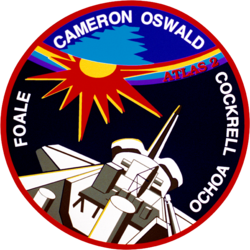STS-54
| STS-54 | |||||
 | |||||
| Uppdrag | 53 | ||||
|---|---|---|---|---|---|
| Rymdfärja | Endeavour (3)[1] | ||||
| NSSDC-ID | 1993-003A[2] | ||||
| Färdens tid | 5 dagar, 23 timmar, 38 minuter, 19 sekunder | ||||
| Uppskjutning | |||||
| Startplats | Startplatta 39B vid Kennedy Space Center i Florida | ||||
| Start | 13 januari 1993, 8:59.30 a.m. EST | ||||
| Landning | |||||
| Landningsplats | KSC Runway 33 | ||||
| Landning | 19 januari 1993, 8:37.47 a.m. EST | ||||
| Omloppsbana | |||||
| Varv | 95 st[3] | ||||
| Apogeum | 309 km | ||||
| Perigeum | 302 km | ||||
| Banlutning | 28,45° | ||||
| Sträcka | 4,025 miljoner km | ||||
| Rymdpromenad | |||||
| Antal | 1 st | ||||
| Total tid | 4 timmar, 28 minuter | ||||
| Besättning | |||||
| Befälhavare | John H. Casper (2) | ||||
| Pilot | Donald R. McMonagle (2) | ||||
| Uppdragsspecialister | Mario Runco, Jr. (2) Gregory J. Harbaugh (2) Susan J. Helms (1) | ||||
 | |||||
| Kronologi Rymdfärjeprogrammet | |||||
| |||||
STS-54 var en rymdfärjeflygning i det amerikanska rymdfärjeprogrammet. Det var den tredje flygningen med rymdfärjan Endeavour. Den sköts upp från Pad 39B vid Kennedy Space Center i Florida den 13 januari 1993. Efter nästan sex dagar i omloppsbana runt jorden återinträdde rymdfärjan i jordens atmosfär och landade vid Kennedy Space Center.
Se även
Referenser
- ^ NASA Space Shuttle Launch Archive Arkiverad 30 augusti 2013 hämtat från the Wayback Machine., läst 28 juli 2016.
- ^ ”NASA Space Science Data Coordinated Archive” (på engelska). NASA. https://nssdc.gsfc.nasa.gov/nmc/spacecraft/display.action?id=1993-003A. Läst 19 mars 2020.
- ^ Manned Astronautics - Figures & Facts Arkiverad 4 mars 2016 hämtat från the Wayback Machine., läst 28 juli 2016.
Externa länkar
 Wikimedia Commons har media som rör STS-54.
Wikimedia Commons har media som rör STS-54.
| ||||||||
| ||||||||||||||||||||||||||||||||
Media som används på denna webbplats
Emblem of Nasa's STS-53 mission
- Designed by the crewmembers, the STS-53 insignia shows the Space Shuttle Discovery rising to new achievements as it trails the symbol of the Astronaut Office against a backdrop of the American flag. The five stars and three stripes also serve to symbolize the mission designation (STS-53) and America's continuing commitment to world leadership in space. The pentagonal shape of the patch represents the Department of Defense (DOD) and its support of the Space Shuttle Program. The band delineating the flag from space includes the four colors of the military services of the crewmembers. The names of the flight crewmembers are located along the border of the patch. They are Commander David M. Walker, Pilot Robert D. Cabana, Mission Specialist (MS) Guion S. Bluford, MS James S. Voss, and MS Michael R. U. Clifford. Each crewmember contributed to the design of the insignia.
STS-54 Mission Insignia
STS-56 Mission Insignia
Författare/Upphovsman: Pascal (Flickr user: pasukaru76), Licens: CC0
Vostok spacecraft replica at the Technik Museum Speyer, Germany.
Astronauts pictured in the STS-54 crew portrait from left to right are: Mario Runco, Jr., mission specialist; John H. Casper, commander; Donald R. McMonagle, pilot; and mission specialists Susan J. Helms, and Gregory J. Harbaugh. Launched aboard the Space Shuttle Endeavour on January 13, 1993 at 8:59:30 am (EST), the crew deployed the fifth Tracking and Data Relay Satellite (TDRS-6).






